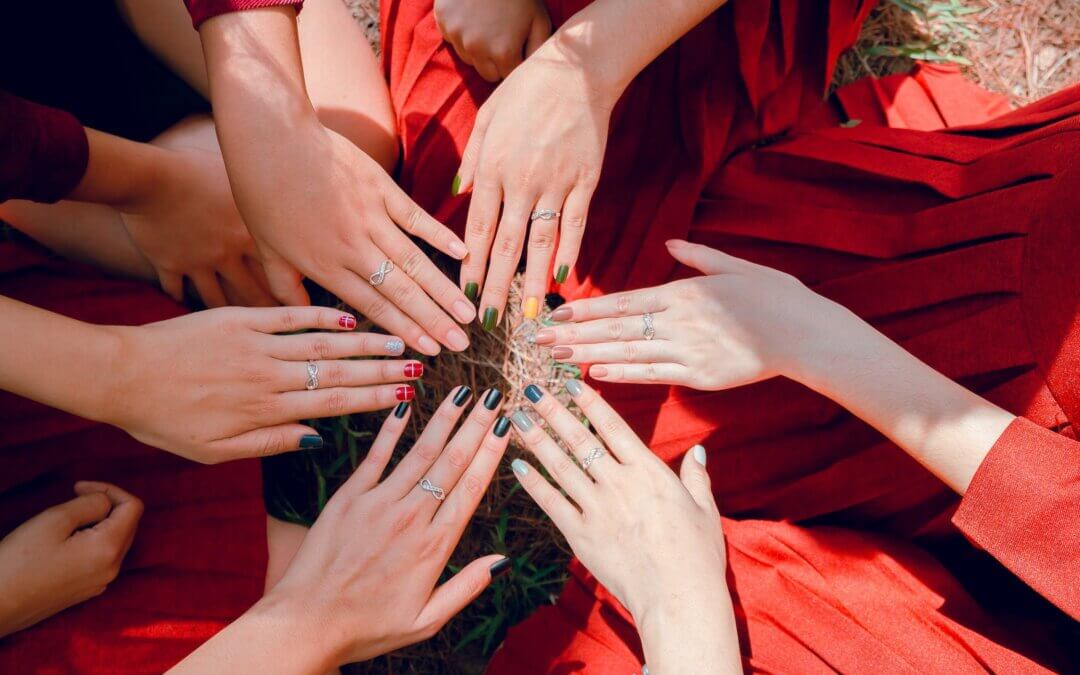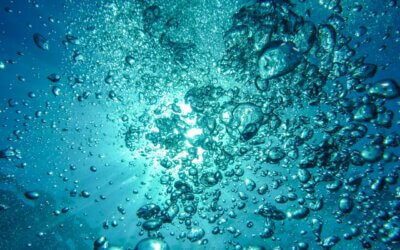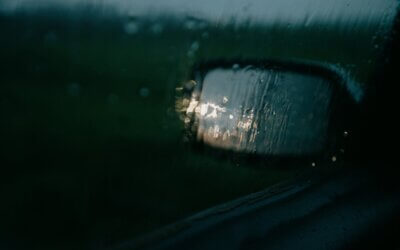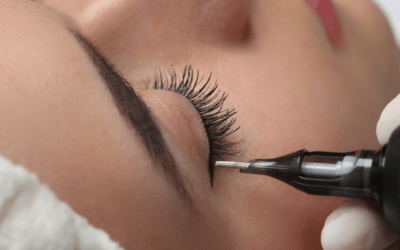Gel manicure, classic manicure, Shellac manicure, acrylics, hard gel, overlay, shellac forte, dip powder mani, SNS, Japanese or Russian manicure … wait, we lost you? Ok, let’s just take a pause here because you may already be exhausted to read the list. Honestly, we can’t blame you! If you’re new to the world of salon manicure and toying with the idea to try something new, you may find this world of technical jargon rather confusing. Let us guide you through the mani jungle and demystify what’s behind which fancy manicure name.
First thing first: What actually is a manicure?
The word itself originates from the Latin manus, for hand, and cura, which means care.
Manicure is a cosmetic treatment on the fingernails and hands. It can be performed by yourself at home, or you can leave it to a professional in a nail salon. If you decide to get it done in a salon or nail studio, you’ll be served by a professional nail technician, aka manicurist, nail tech, or nail professional.
Any service that’s described as a manicure in a nail studio should always consist of the following steps:
- filing and shaping the edges of your nails
- removing any non-living tissues such as cleaning your cuticles and clipping any hangnails
- some sort of work on your nails eg. application of polish, or buffing and smoothening without a drop of colour – this depends on the type of manicure you’re after
- application of a cuticle care oil solution
- and a nice hand massage to finish it off
Now, the magic happens around the ‘some sort of work on your nails’ part, and that’s where this A-Z guide will come handy. Let’s dive in.
Acrylic Manicure (aka Acrylic Nail Extensions)
What is an Acrylic Manicure like?
Acrylics are a combination of a liquid monomer and a powder polymer. Your nail technician uses these two liquids to form a paste which is then bonded to your natural nails. Your manicurist then gives it the desired shape. It hardens in place and adds strength, length, and thickness to your nails.
Acrylics should last six to eight weeks with an infill needed about every two to three weeks, depending on how fast your nail grows. An infill literally fills the gap that occurs as your nail grows. It’s a touchup between the bottom of the nail and the cuticle.
Benefits of an Acrylic Manicure
With acrylic nails, you can go as wild as you like, no matter the natural shape of your nails. They can add length (some people like it extra-extra long) and they also provide an excellent canvas for wonderful works of nail art.
Cons of an Acrylic Manicure
Acrylics must be removed by a professional nail technician to avoid any damage to your nails. The removal process can weaken your natural nails, but when done properly it won’t cause any permanent damage. It’s recommended to allow your nails to rest every 3 to 6 months when having acrylic nails.
Classic Manicure
What is a Classic Manicure like?
Classic manicure is when normal nail polish aka nail varnish is applied after thorough preparation of your nails. In our salon, we use the brand OPI and their Nail Laquer product range for this particular service. You select the colour which lasts up to 7 days. You can easily remove the colour at home using any kind of nail varnish remover.
Some salons offer an upgrade to a classic manicure by offering a nail varnish that lasts longer than 7 days. We use OPI’s Infinity Shine product range for this particular service. It costs just a little bit more than the actual classic manicure, but offers up to 11 days of colour. Again, you can easily remove it at home using any kind of nail varnish remover.
Benefits of a Classic Manicure
The classic manicure is affordable and can last for at least a week. The nail varnish is easy to remove at home with acetone or acetone-free nail polish remover.
Cons of a Classic Manicure
A classic manicure doesn’t last as long as a gel polish. It’s more prone to chipping.
Dip Powder Manicure
What is a Dip Powder Manicure like?
A Dip Powder mani is made with a certain powder and glue mix. This combo creates a long-lasting bond on your nails that doesn’t require any UV light to cure and harden the mix, nor does it come with a strong acrylic smell. The nail technician brushes a coat of resin onto your nail plate. Then, each finger is dipped into the colour powder. Resin is added again. An activator is then brushed on a few times, and finally, a glossy top coat is applied. It can last up to two or three weeks without chipping or fading
The Dip Powder Manicure is also called SNS nails. SNS is actually a brand of dip powder, the same way OPI and Essie are brands of nail polish.
Benefits of a DIP Powder Manicure
No strong smells. No UV light is needed. Clients who have any allergies to acrylics or gel may opt for this method.
Cons of a Dip Powder Manicure
Some people may be prone to develop dermatitis, therefore it’s best to talk to a doctor if that could be an issue for you.
French Manicure
What is a French manicure like?
French manicure is a type of classic manicure when your nail technician applies white colour at the tips of your nails, and a nude / pink-ish colour on the rest of your nail plate. It’s very classy, natural, elegant – simply beautiful. French manicure is done with regular nail polish, the French gel manicure however lasts longer and is done with gel polish under UV light.
Benefits of a French Manicure
The French mani goes with literally any outfit in any season. It’s simply timeless.
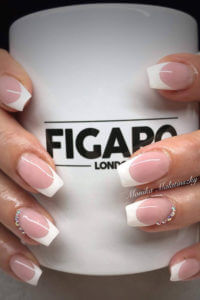
Cons of a French Manicure
If you opt for French manicure with regular nail varnish, it’s more prone to chipping. Also, the final result very much depends on your nail shape and your fingers
Gel Manicure aka Gel Polish (aka Shellac Manicure)
What is a Gel Polish Manicure like?
A Gel Polish (also known as Shellac) is applied in the same way as classic nail varnish, except that the gel is cured under UV light. The UV light hardens the gel polish and makes your manicure last much longer. First, your nail technician primes the nails to remove any dust or moisture from the surface. Then, a base coat is applied and cured under UV light. Then comes the colour of your choice. Finally, a top coat that can be shiny or matte, depending on your wish.
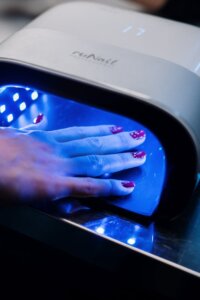
Gel polish curing under UV light
Benefits of a Gel Manicure
A Gel manicure is durable and tougher than a manicure with regular nail varnish. It lasts for at least 2 weeks and the colour looks just as beautiful after a couple of weeks as it did on the day you had it done.
Cons of a Gel Manicure
You can’t remove it as easily as a classic manicure. You need to soak your nails in pure acetone and then remove the gel polish with a cotton pad. You must be careful not to damage your nails by picking and scratching. It’s usually best to let a professional nail technician do it for you in a salon.
Gel Nail Extensions
What is a Gel Nail Extension like?
Professionally sculptured nail extension sets are completely bespoke, they fit your nails perfectly and are super comfortable to wear. A form is customized to the required shape, which is then fitted just beneath the free edge (the tip) of your nails. A layer of builder gel is applied onto your natural nail plate all the way up to the form and the sculpting process begins. It sets and hardens under UV light. Length can be customised according to your request, followed by the application of colour and/or nail art and decoration. See how it’s done in this blog with video.
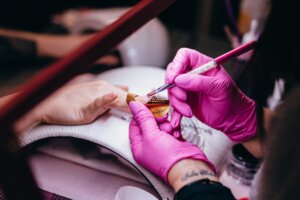
Sculpting gel nail extensions on capture frame
Gel nail extensions can last for up to 6 weeks and just like acrylics, they need an infill every 2-3 weeks, depending on your nail growth to fill the gap between cuticles and the extensions.
Benefits of Gel Nail Extensions
Gel nail extensions are hard and durable, and they look super natural. They’re very comfortable to wear and feel less foreign on your hands. The nail tips are lightweight, and the removal process is easier and quicker compared to acrylics. According to this prestigious medical journal, gel nails are safer and potentially healthier than acrylic nails. Also – you don’t have to endure the strong smells that come with acrylics.
Cons of Gel Nail Extensions
To remove gel extensions safely, you should see a professional nail technician, although they’re certainly easier to remove than acrylics. Therefore, if there’s no chance for you to book an appointment at a nail salon, you can go for it armed with strong acetone, wrapping foil, and a bit of patience.
Hard Gel Manicure aka Hard Gel Overlay aka Shellac Forte Manicure
What is Hard Gel Manicure like?
With this method, your nail technician applies a layer of hard gel onto your nail plate to strengthen it. The gel sets under UV light. Once dry, colour is applied, usually Gel Polish or sometimes, clients prefer normal nail varnish. When the nail starts to grow, the gap is then filled with hard gel upon your next nail appointment. This service is called ‘infill’. It’s slightly cheaper than the hard gel manicure as it doesn’t take that much time.
Benefits of a Hard Gel Manicure
It’s strong and lasts even longer than your usual Shellac. It’s a popular choice with clients whose natural nails are weak and thin.
Cons of a Hard Gel Manicure
The disadvantage of a hard gel manicure is that it can only be removed by a professional nail technician. You can remove the top colour layer at home, but the rest has to be done by a qualified professional.
To see photos and learn more about our Shellac Forte service, click here.
Japanese Manicure
What is a Japanese Manicure like?
The Japanese Manicure, an ancient Japanese technique, is about buffing nutrients deep into your nail bed to make your nails super healthy so that they shine on their own without the need for a drop of polish. The peculiarity of this treatment is that all the products used for it are made from natural materials: no synthetic chemicals of any kind are used.
This specific type of manicure is highly recommended for damaged nails (fragile, brittle and splitting nails). It helps to restore them to their pure-healthy pink shade and their natural shine. This is due to the ingredients contained in the natural paste applied during the treatment: vitamin A and E, keratin, bee’s wax and silica from the Sea of Japan. To see photos and learn more, check also this blog.
Benefits of a Japanese Manicure
The beneficial effects of a Japanese manicure treatment are visible immediately after the procedure: Healthy nails that shine on their own, without the need for a drop of polish. May last up to 2 weeks if you avoid harsh household chemicals.
Cons of a Japanese Manicure
If you want nothing but natural shine and healthy nails, there’s virtually nothing we can think of that would speak against a Japanese manicure. Bear in mind that after this type of mani, you have to wait at least 3 or rather 4 weeks until a classic or gel manicure.
Overlay
See Hard Gel Manicure
Russian Manicure
What is a Russian manicure like?
What sets this manicure apart from the traditional routine is the cuticle work. During a Russian manicure, the technician uses an electric file or drill to remove excess skin surrounding the nailbed to achieve a crisp, clean finish.
Benefits of a Russian manicure
Absolutely clean, spotless cuticles.
Cons of a Russian manicure
As it’s a very intricate process, it requires absolute precision to avoid any damage to the nail bed.
Shellac Manicure
See Gel Manicure
Shellac Forte Manicure
See Hard Gel Manicure
SNS Nails
See Dip Powder Manicure
Any manicure questions that we haven’t answered? Leave a comment below and let us know.
Great nails don’t happen by chance. They happen by appointment.
Book yours today at Figaro London, with Melania.
Love,
Figaro London

